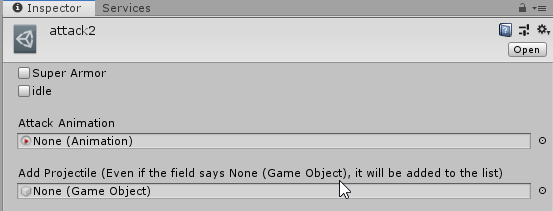Io Dev Blog 1
February 2nd, 2020 ~ February 16th, 2020
Fixing Git LFS problems and developing editor tools for creation of boss attacks.
Git LFS Problems

For this sprint I was going to build a scriptable object for the boss attack that would be used for Project Blue and possibly future games, but unfortunately, I ran into a rather interesting git error. A plugin we had decided to use, DOTween, began returning compiler errors. Unity was unable to read a single .dll file, which caused 177 cascading errors. After much effort, it was discovered that .dll files were tracked by Git LFS, and for some reason, they were still stored as text pointers. How Git LFS works, is that it tracks certain types of large files, and it stores them as text pointers, and only redownloads them when they are changed to safe space and time. Normally, when you clone a repo, any files tracked by Git LFS are downloaded as text files that contain the text pointer and version info. Git LFS then goes through those files and downloads them from the repository, replacing the text files. What we realized was that for some reason, Git LFS was failing to download the files and leaving them as text pointers. We found several methods of fixing this. The easiest one was deleting the local copy of the repo, recloning the repo, and reinitializing Git LFS. Doing this multiple times eventually results in the bug being fixed. A more difficult, albeit far faster method of fixing this is finding the specific files that had been affected, deleting them, and using git checkout to redownload them. This fixed all the errors, and I was able to instruct other students on the team who had similar errors pop up on their computers.

Template Boss Attack ScriptableObject
After all the problems with Git LFS were mostly resolved, I began work on the Template Boss Attack Scriptable Object.
The main components that were needed were a List of objects to be spawned during the attack, and the position and
rotation of each of those objects. Also, a bool to control the boss's superarmor state, and another bool that would
conditionally show a float field for idle time after the attack. I first had to learn how to use ScriptableObjects
in Unity. A ScriptableObject is a data container that you can use to save large amounts of data, independent of class
instances. What we wanted to do is have a template ScriptableObject that we could make any type of attack instance
based off it, which could be used for all boss fights in Project Blue, and possibly for future projects as well.
Making the ScriptableObject and creating the variables to store the data, and necessary functions did not take very
long, as it was very similar to just making a script based off MonoBehaviour. The part that was truly difficult and
time consuming was making this user-friendly enough that non-programmers would be able to use it from the inspector
without touching the code. I quickly realized that the most optimal way to do this would be to write a custom editor
script, which I had to teach myself how to do. After familiarizing myself with the functions and syntax of the Unity
CustomEditor class and EditorGUILayout class, the first thing I implemented was the toggleable idleTime field. I
used EditorGUILayout.Toggle to create a toggle button linked to a bool, which when set to true, would create a new
Editor element, in this case a EditorGUILayout.FloatField, for the time the boss would idle after the attack. The
next big hurdle was creating a field that you could drag attack projectile prefab into, and automatically add those
to a list of projectiles that you could select from the inspector. What I ended up doing is having a
EditorGUILayout.ObjectField, that, when a prefab is dragged into it, would set the private GameObject projectile
to be a copy of it, and then set the target of the ObjectField to null, emptying the field. So, when a prefab is
dragged in, it disappears so more can be dragged in afterward. The difficult part was adding any new projectile
prefabs to a dropdown list that could be selected from. After many, many different attempts using various methods,
I ended up using a very roundabout way. I had a List<GameObject> called projectiles and a List<string> called names,
and a 2 int variables that were used to check if any prefabs had been added by checking the size of the lists. When
a prefab is dragged into the ObjectField, it is automatically added to the end of the projectiles List. projectiles.Count
would increase, which would trigger another function, which deleted the names List, and rebuilt it, going through a
loop projectiles.Count times, adding in new strings that were equal to the name of each GameObject in projectiles,
so the indexes would line up. Then, a dropdown list will automatically build itself from the names List, with the
output index being remapped to projectiles, which would be set to the currentProjectile, which is the type of projectile
chosen in the Inspector.
The next big task was making writable fields for the coordinates and rotation of each projectile to be spawned, the
number of projectiles being decide in the Inspector by an IntField. What I ended up doing is making a class that held
the x and y coordinates and rotation of a projectile, alongside a custom constructor. There is a list of these structs,
and whenever the number of projectiles is changed, the Editor is rebuilt to list Slider fields for coordinates and
rotation of each projectile, with numbered labels. Since the data is stored in a List of Classes, the data is preserved
even if several are deleted.
Afterward, I had to write the public Attack() function, which would instantiate projectile prefabs at the according
locations, and idle if applicable. However, I discovered that scripts derived from ScriptableObject were unable to
use Coroutines, so the idling itself had to be passed off to the State Machine, which would be controlling the boss itself.
Limitations and Future Tasks
Some things I have to continue working include are adding in a method to remove prefabs from the projectiles list. Currently there is no way to do so, and the only method is to delete the specific ScriptableObject and recreate it. Also, I intend on using DrawGizmo to allow students from the design team to drag the projectiles around the sceneand rotate them, so they do not have to manually adjust the coordinates. Also, I intend on modifying the ScriptableObject to allow manual selection of type of projectile prefab for each projectile that is instantiated.
WolverineSoft Labs
For the WolverineSoft Labs, we formed project teams and each team made a specific game idea to focus on for the semester. The current game teams are untitled-bug-game, ascension, and awoken. Team untitled-bug-game decided to make a 2-way tower defense game similar to Autochess. Team ascension decided to make a game similar to Nidhogg, except the gameplay takes place on a vertical axis instead of a horizontal one. Team awoken decided to make a top-down pvp tank fighting game. The teams have started work on the MVPs, and the less experienced members have been working on basic Unity tutorials so they can begin to contribute.